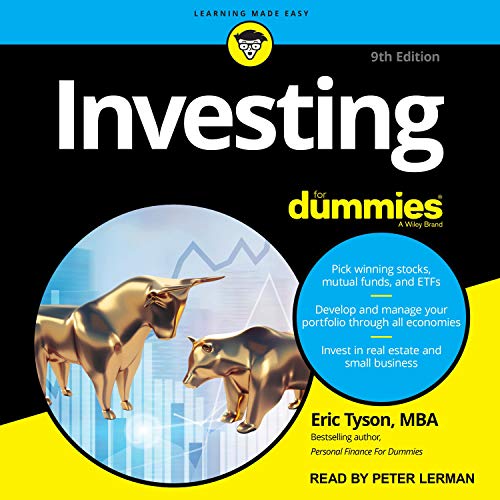Eric Tyson’s “Stock Investing for Dummies” audiobook offers practical advice on stock investing for beginners. It covers essential strategies and tips for successful investments.
Investing in stocks can be daunting for beginners. Eric Tyson’s “Stock Investing for Dummies” simplifies this complex world. The audiobook provides a comprehensive guide that breaks down the basics of stock market investing. Tyson uses clear language and straightforward examples to make investing accessible.
Listeners learn how to evaluate stocks, understand market trends, and build a diversified portfolio. Practical tips help avoid common pitfalls and make informed decisions. Whether you’re new to investing or looking to refine your strategy, this audiobook is a valuable resource. It empowers listeners to take control of their financial future with confidence.

Introduction To Stock Investing
Eric Tyson is an experienced financial expert. He has written many books on finance. His work helps people understand money. Eric has a degree from Yale. He also has an MBA from Stanford. Eric’s career started in management consulting. Later, he became a financial advisor. Eric’s advice is trusted by many. He has helped millions with their finances.
The audiobook teaches beginners about stocks. It makes stock investing easy to understand. Eric explains complex terms in simple words. The goal is to help listeners make smart investments. The audiobook covers basic and advanced topics. Listeners learn how to buy and sell stocks. They also learn how to avoid common mistakes. The audiobook aims to build confidence in investors.

Basics Of The Stock Market
Stocks represent ownership in a company. They are also called shares or equities. Owning a stock means you own a part of the company. This ownership allows you to earn profits when the company does well. Stocks can be bought and sold on the stock market. People invest in stocks to grow their wealth.
The stock market is where stocks are bought and sold. It operates like an auction. Buyers and sellers trade stocks through exchanges. Popular exchanges include the New York Stock Exchange and NASDAQ. Prices of stocks change based on supply and demand. Companies list their stocks on the market to raise money. Investors buy stocks hoping they will increase in value.
Building A Strong Investment Foundation
Financial goals guide your investment journey. Clear goals make tracking progress easy. Start with short-term goals like saving for a trip. Next, set long-term goals such as retirement. Knowing your goals helps in making better investments.
Investing always involves risk and reward. Higher risk can bring higher rewards. Lower risk may result in smaller gains. Balance is key. Diversify your investments to spread risk. This means not putting all your money in one place. Understand your risk tolerance and invest accordingly.
Analyzing Stocks
Fundamental analysis looks at a company’s financial health. This includes earnings, expenses, and assets. It helps to understand a stock’s true value. Key metrics include the price-to-earnings ratio and earnings per share. These help investors decide if a stock is undervalued or overvalued. Good fundamentals often suggest a strong company.
Technical analysis examines price movements and trading volumes. It uses charts to predict future stock prices. Common tools include moving averages and trend lines. Patterns like head and shoulders and double bottoms are also studied. This method helps in timing the market for buying and selling. Short-term traders often rely on technical analysis for quick decisions.
Strategies For Stock Selection
Value investing focuses on finding stocks priced lower than their true value. Investors seek bargain stocks with strong fundamentals. They analyze financial statements to identify undervalued companies. Patience is key as stocks may take time to rise. Investors look for a margin of safety to protect against losses.
Growth investing targets companies expected to grow faster than the market. Investors focus on high earnings growth and innovative products. They prefer companies with competitive advantages and strong leadership. Higher risk is involved, but the potential rewards are great. Investors often reinvest profits for compounding returns.
Portfolio Management Essentials
Diversification spreads risk across different investments. This reduces the impact of a single poor-performing asset. A well-diversified portfolio includes stocks, bonds, and other assets. Mixing industries and sectors also helps. This balance protects against market swings. Aim to invest in different asset classes. This way, your portfolio remains stable.
Rebalancing keeps your portfolio aligned with goals. Over time, some investments may grow faster. This can change your portfolio’s risk level. Selling some high-performing assets can help. Buying underperforming assets also maintains balance. Regular rebalancing ensures your investments match your risk tolerance. Set a schedule for rebalancing, like quarterly or annually. This keeps your investments on track.
Avoiding Common Investing Pitfalls
Emotional investing often leads to poor decisions. Fear and greed can cloud judgment. It’s crucial to stay calm. Stick to a plan. Avoid making impulsive choices. Emotions can cause you to buy high and sell low. This is a common mistake. Try to keep feelings in check. Focus on long-term goals. Stay disciplined and follow your strategy.
Timing the market is very hard. Even experts struggle with it. Predicting highs and lows is nearly impossible. Many investors miss out on gains. They sell too soon or buy too late. Sticking to a consistent investment plan is better. Regular investments can reduce risks. This strategy helps in the long run.
Future Trends In Stock Investing
Technology is changing stock investing. People use apps and websites to buy stocks. These tools are fast and easy to use. You can track stock prices in real-time. Robots can even help you trade. They use smart algorithms. This makes investing easier for everyone. More people are joining the stock market. They feel more confident. Technology is making investing more fun and less scary.
Events around the world affect stock prices. Wars, natural disasters, and political changes can cause prices to rise or fall. Global companies also impact stock markets. Their success or failure can change stock values. Trade deals between countries matter too. They can open or close markets. Investors need to watch global news. This helps them make better choices.

Conclusion
Eric Tyson’s “Stock Investing for Dummies” audiobook is a must-listen for beginners. It simplifies complex concepts, making stock investing accessible. Enhance your financial knowledge with this valuable resource. Start your investment journey confidently with Tyson’s expert guidance. Don’t miss this opportunity to become a savvy investor.



